Normally, in absolutely healthy women, you can detect CA 15-3 tumor marker. Doctors do not consider such changes to be a pathology if the amount of antibodies in the blood is minimal.
Record content:
- 1 Functions in the body
- 2 How and under what conditions is it produced
- 3 Indicator table is normal
- 4 Increase symptoms
- 5 Reasons for the increase
- 6 Indications for research
- 7 How is it determined
- 8 Preparation and analysis
- 9 Decoding the results
- 10 When to see a doctor
- 11 Possible complications
- 12 Video about tumor marker CA 15-3
Functions in the body
CA 15-3 tumor marker refers to glycoprotein proteins with a carbohydrate base. This antigen is formed in response to the appearance of cancer cells in the mammary gland.
It is a protein structure consisting of a combination of a protein with a carbohydrate - a glycoprotein. CA 15-3 tumor marker, the norm in women, suggests the absence of antibodies generated by cancer cells.
How and under what conditions is it produced
CA 15-3 Is a highly specific antigen, therefore it is used as a tumor marker. The antigen is found in 95% of cases of malignant breast lesions. In rare cases, the appearance of a specific protein in the blood is associated with other types of cancer, for example, with the growth of a tumor in the intestine.
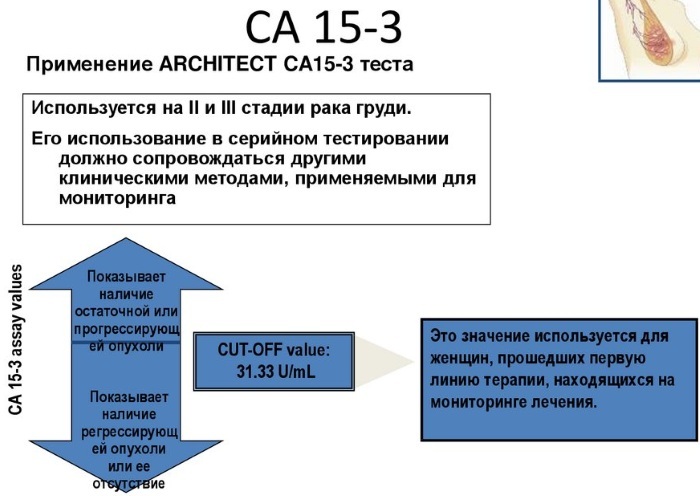
It is synthesized by the membranes of cancer cells located in the mammary gland. In addition to blood, the antigen can be found in the secretion of the mammary gland.
Indicator table is normal
| Tumor marker level | |
| normal amount | up to 20 units / ml |
| threshold limit | 30 units / ml |
| high level | over 30 units / ml |
| very tall | above 50 units / ml |
CA 15-3 is a tumor marker, the rate in women is not the same and depends on the laboratory in which the study was carried out. It is necessary to compare the available result with the standards accepted in this medical institution.
Increase symptoms
CA 15-3 tumor marker (the norm in women should not be a reason for refusing further examination.
In the initial stages, the appearance and growth of antigen volumes in the serum does not externally manifest itself in any way. As the tumor grows, the concentration of a specific protein in the body increases and symptoms appear that indicate the presence of a malignant neoplasm in the breast
Reasons for the increase
In addition to breast cancer, there are a number of pathologies in which it is possible to detect a specific protein in the blood.
These conditions include:
- inflammation of the biliary tract
- cirrhosis, viral hepatitis
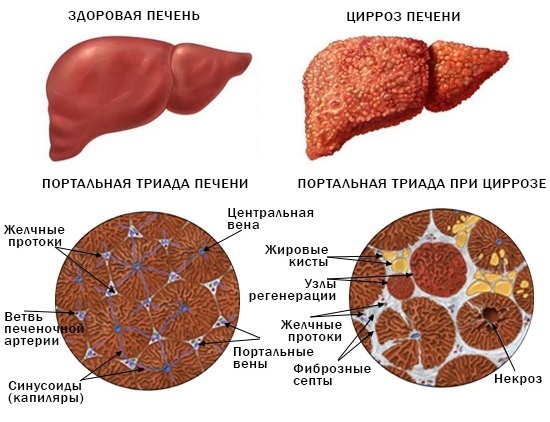
Cirrhosis of the liver - some types of changes in the lungs
- kidney pathology,
- rheumatic changes in the body.
Occasionally, the appearance of an antigen is observed in pregnant women. This phenomenon is observed during hormonal changes in the body, immune stress associated with fetal growth and the body's response to the presence of foreign cells in the body.
CA 15-3 tumor marker is the norm in women, it is restored after the birth of a child to the prescribed 20 U / ml. Such a reaction is individual and depends on the state of the organism of the expectant mother.
The development of breast cancer is most often promoted by the increased activity of the glands that produce the hormone estrogen. Its high concentration leads in some cases to the formation of a tumor. With the onset of pregnancy and during lactation, the volume of estrogen drops to a minimum, so the likelihood of breast carcinoma growth is minimal.
More often, an increase in the level of tumor markers in the blood occurs against the background of frequent abortions.
Indications for research
The purpose of the blood test is to detect a malignant tumor of the mammary glands at a stage when there are no visible signs of ongoing changes.
A blood test in order to identify a tumor marker of this type is prescribed in cases when:
- it is necessary to differentiate breast cancer from mastopathy;
- there is a threat of metastasis with the risk of secondary malignant tumor formation;
- it is necessary to determine how effective the course of treatment is;
- trying to determine how aggressive the tumor is. The higher the concentration of antibodies, the more cells the tumor consists of.
Without fail, an examination is prescribed after the patient has recovered, in order to exclude relapses of the disease. The secondary appearance of a tumor is possible several years after remission.
In the presence of proven mastopathy, a study for tumor markers is not carried out. If breast cancer is suspected, the secretion secreted from the nipples is examined in parallel with the blood.
The decision to send a patient for analysis is made by an oncologist, gynecologist or mammologist. The material is taken in the laboratories of the oncological dispensary or in specialized clinics. In ordinary district polyclinics, there is no equipment that allows the study of blood serum at the proper level.
How is it determined
To identify a tumor marker in serum, an immunochemiluminescence assay is used. This method is similar to the enzyme-linked immunosorbent assay in the way it is carried out. The essence of the immunochemiluminescence study lies in the use of specific magnetic particles that have a high degree of sensitivity.
During the study of sera, the immune responses of combining a specific antigen with a specific antibody are detected. Such reactions are unique, which makes it possible to prove with high accuracy the presence of pathological changes.
Plasma research is carried out using an automatic immunochemiluminescence analyzer.
The likelihood of receiving false data is low.
The error can be caused by:
- improper actions of a laboratory assistant when taking blood;
- non-compliance by the patient with the conditions of preparation for the examination.
For a more accurate diagnosis, it is additionally carried out with a blood test for cancer-embryonic antigen. If the test is negative and there are visible signs of breast cancer, the examination is repeated.
At the initial stages of pathology, the concentration of antigens may be low and specific proteins will not be detected by traditional laboratory tests. In this case, repeated analysis is carried out after a short period of time.
Preparation and analysis
The collection of material for research is a completely safe procedure. Her task is to get the most accurate result.
To do this, you must meet a number of conditions:
- Blood sampling is carried out in the morning on an empty stomach.
- The last meal should take place twelve hours before the examination.
- At the last meal, dishes containing a large amount of fat and hot spices are completely excluded from the diet.
- A few days before the visit to the laboratory, the use of alcohol and alcohol-containing drinks, energy drinks with a high level of caffeine is prohibited. These substances can affect the composition and condition of the blood.
- Smoking is prohibited for the hours leading up to a visit to the laboratory.
- On the eve of the examination, stress is avoided and the level of physical activity is limited.
- For several days before the examination, it is recommended not to take medications, especially those that suppress the immune system, as well as drugs belonging to the group of corticosteroids and tranquilizers. An exception is made for essential medicines. Their name and dose must be indicated on the direction.
- If necessary, it is allowed to use non-carbonated water before analysis.
- Receiving material
- The material is taken in a treatment room under conditions of increased sterility.
- Blood is drawn from the cubital vein only by a healthcare professional.
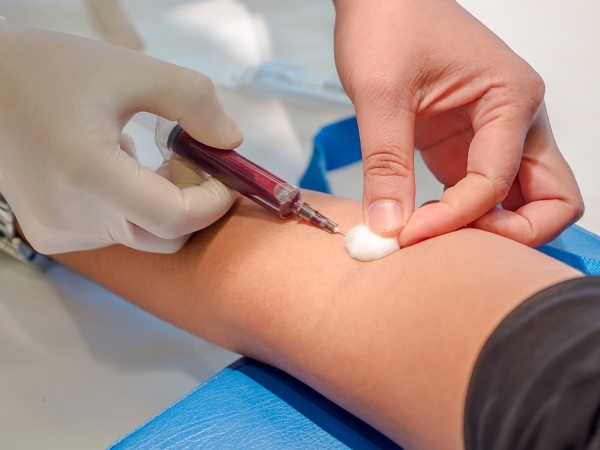
- Minor discomfort may appear with an increased pain threshold in the patient.
Decoding the results
CA 15-3 tumor marker, the norm of which in women, is not yet an indicator of the absence of the disease.
Evaluation of the results obtained is carried out by an oncologist, gynecologist or mammologist:
- The doctor states that there is no tumor in the absence of tumor markers in the blood or their insignificant detection is not more than 27 IU / ml.
- A negative test result is possible when the patient recovers.
- There are no antibodies in serum if tumor growth has just begun.
A one-time increase in titer does not indicate the presence of disease. Changes in the body must be confirmed by other diagnostic methods. Re-examination must be carried out four weeks after the first result is obtained. If there are no dynamics, then they look for other causes not related to breast cancer.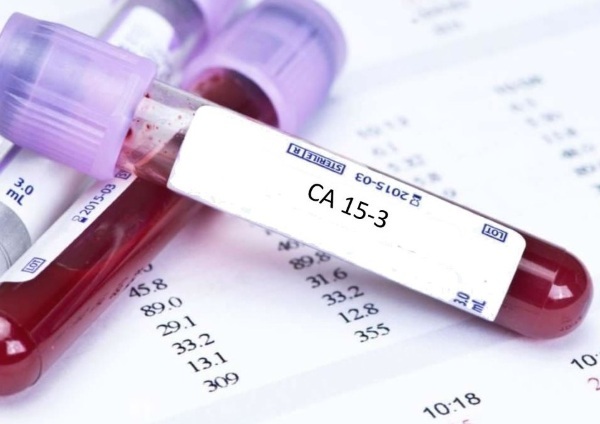
Re-increase in titer. With indicators above 27 IU / ml.
Assumes the presence of:
- stomach cancer
- liver cancer
- pancreas cancer
- cancer of the ovaries, endometrium, uterus, mainly in the late stages of tumor development.
When diagnosing benign processes:
- with localization in the mammary glands;
- cirrhosis of the liver, the number of tumor markers does not exceed the level of 50 units / ml;
- physiological increase in CA 15-3 in the presence of pregnancy in the third trimester. The concentration of the tumor marker approaches 50 U / ml;
- autoimmune diseases.
CA 15-3 tumor marker, the norm in women in the normal state is 27 units / ml, during gestation against the background of hormonal changes in the blood, sometimes reaches over 35–39 units / ml. The serum tumor marker level can be affected by the presence of sarcoidosis and tuberculosis in the body.
When to see a doctor
In the early stages of breast cancer:
- Unusual formations are felt in the mammary gland. Very often, the tumor can be small and overlooked.
- A characteristic feature of this structure is its painlessness. Most often, a growing cancer in the initial stages is not a cause for concern.
- Areas with retracted skin are revealed.
- In the later stages of the disease, soreness appears in the place where the tumor grows.
- A change in the nipple is found, which becomes thickened and swollen.
- The nipple is pulled into the chest. In this case, you can look for a tumor in this particular area.
- Discharge from the nipple is not associated with pregnancy and breastfeeding. Normally, the presence of minor secretions associated with changes in hormonal levels is permissible. At the same time, the amount of discharge is insignificant and there are no blood impurities in them. In the presence of pathological changes, the amount of discharge increases sharply.
- There is an increase in the lymph nodes in the armpit, they form a bunch of grapes.
- With advanced pathology, a blood test for a tumor marker is carried out in the presence of the following symptoms:
- Tumors that are easily detected by palpation of the breast.
- Changing the location of the seal when the nipple is pulled.
- Thickening of the skin around the nipple.

The signs of cancer in all women are the same, the symptoms that arise as the tumor grows may differ.
There are many forms of breast cancer, but they all have one thing in common - the appearance of enlarged lymph nodes in the armpit. If such a symptom is found, contacting a doctor is mandatory. As a rule, when studying blood, even normally, an increase in the concentration of a tumor marker is found.
At the discretion of the attending physician and in the presence of alarming symptoms, persons who are at risk of developing cancer are sent for blood tests breast and other pathologies:
- Patients in whose families have already been diagnosed with breast cancer
- Women over the age of forty
- If the patient has been taking hormonal contraceptives for a long time
- Persons with atypical hyperplasia
- Patients with a persistent increase in the level of estrogen in the blood
- Pregnant for the first time after thirty years
- Women suffering from long-term infertility
- Patients with a history of breast and ovarian cancer detection
- Women with late menopause
- Persons by occupation in contact with radioactive substances.
- How to bounce back
- In the presence of an increased value of the tumor marker in the blood, measures are taken to identify the reasons that led to the changes.
- When a diagnosis is made, a course of treatment is prescribed, which may be conservative or requiring surgery. Upon completion of therapy, the level of antibodies drops to minimum values or specific proteins disappear completely.
Conservative treatment includes:
- Radiotherapy. Refers to the category of supportive treatment. It is performed before or after removal of the tumor. During the procedure, degenerated cells are destroyed.
-
Intrabim. Intraoperative radiation. Radiation therapy is performed during the operation, the effect is carried out on the area where the tumor was located. In this case, the risk of damage to healthy tissues is significantly reduced and relapses of the disease are excluded. The body's recovery time is reduced by six weeks.
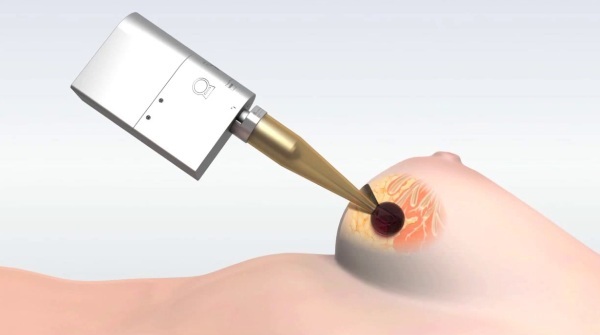
- Chemotherapy. Which belongs to medical methods. The patient is prescribed drugs of a toxic group that destroy mutated cells. They resort to a similar technique in case of impossibility of surgical intervention. The result of the action of chemotherapy drugs is the destruction of proteins responsible for the growth and division of cancer cells. In some cases, DNA and RNA chains of diseased cells are destroyed.
- Hormone therapy, rarely used, only in a situation where the tumor is influenced by drugs belonging to this group.
- Targeted therapy considered the mildest form of treatment for breast cancer, since the effect is exclusively on cancer cells. For this, special drugs are prescribed.
Of the drugs, patients are prescribed:
- Maxipim in injections. The solution is administered intramuscularly daily for two weeks.
- Penicillin prescribed with an established diagnosis of fibrocystic mastopathy. An antibiotic in this case is necessary to eliminate the symptom of inflammation and tissue edema. The daily dose is two tablets.
-
Tamoxifen, hormonal drug. It is prescribed to restore hormonal levels. Which contributes to the disappearance of the tumor.

- Femoden. It also affects hormone levels. Under its influence, the tumor disintegrates.
Even after receiving a negative result, the patient continues to be monitored. She is assigned preventive examinations, laboratory examinations are carried out. Most often, such observation is carried out for life, since the likelihood of a return of the disease remains.
Possible complications
If abnormalities are detected in the blood, self-medication is prohibited.
A high volume of tumor markers in the blood is observed in advanced forms of cancer, developing mammary glands.
- This means that breast tissue is being destroyed. The growing tumor compresses and destroys healthy tissues that form the mammary gland and milk ducts, which leads to the development of severe inflammation, up to necrotic changes.
- There is a high likelihood of metastases in organs and systems located far from the mammary glands. Cancer cells with blood are carried throughout the body and serve as the basis for the appearance of new malignant neoplasms. In this case, doctors give an extremely unfavorable prognosis.
First of all, metastases germinate:
- Into the lung tissue, which is actively supplied with blood and nutrients. In this case, there will be signs of suffocation, often occurring against the background of ongoing pneumonia.
- Into the liver tissue. With the formation of metastases in the liver, symptoms of hepatitis appear.
- Into the brain. With the growth of metastases in the brain, vision, hearing, sleep deteriorate, convulsions appear mainly at night, consciousness is impaired and the thinking process changes.
With the formation of metastases, the likelihood of death is always high. CA 15-3 is a tumor marker, without pathology, the norm in women of which is quite low, in this case it will many times exceed normal values. Most of the methods used in the treatment of oncological diseases at this stage of cancer are ineffective. Such patients are treated in specialized hospices.
Video about tumor marker CA 15-3
CA 15-3 tumor marker:



